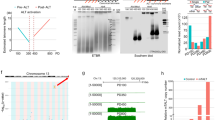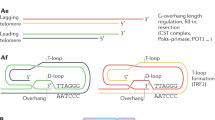Abstract
Human chromosomes terminate in a series of T2AG3 repeats1, which, together with associated proteins, are essential for chromosome stability2,3. In somatic cells, these sequences are known to be gradually lost through successive cells divisions4,5; however, information about changes on specific chromosomes is not available. Individual telomeres could mediate important biological effects as was shown in yeast, in which loss of a single telomere results in cell-cycle arrest and chromosome loss6. We now demonstrate by quantitative fluorescence in situ hybridization (Q-FISH; ref. 7) that the number of T2AG3 repeats on specific chromosome arms is very similar in different tissues from the same donor and varies only to some extent between donors. In all sixteen individuals studied, telomeres on chromosome 17p were shorter than the median telomere length—a finding confirmed by analysis of terminal restriction fragments from sorted chromosomes. These observations provide evidence of chromosome-specific factors regulating the number of T2AG3 repeats in individual telomeres and raise the possibility that the relatively short telomeres on chromosome 17p contribute to the frequent loss of 17p alleles in human cancers.
This is a preview of subscription content, access via your institution
Access options
Subscribe to this journal
Receive 12 print issues and online access
$209.00 per year
only $17.42 per issue
Buy this article
- Purchase on Springer Link
- Instant access to full article PDF
Prices may be subject to local taxes which are calculated during checkout
Similar content being viewed by others
References
Moyzis, R.K. et al. A highly conserved repetitive DNA sequence (TTAGGG)n, present at the telomeres of human chromosomes. Proc. Natal. Acad. Sci. USA 85, 6622–6626 (1988).
Blackburn, E.H. & Greider, C.W., eds., Telomeres (Cold Spring Harbor Laboratory, Cold Spring Harbor, New York, 1995).
Blasco, M.A . et al. Telomere shortening and tumor formation by mouse cells lacking telomerase RNA. Cell 91, 25–34 (1997).
Hastie, N.D. et al. Telomere reduction in human colorectal carcinoma and with ageing. Nature 346, 866–868 (1990).
Harley, C.B., Futcher, A.B. & Greider, C.W. Telomeres shorten during ageing of human fibroblasts. Nature 345, 458–460 (1990).
Sandell, L.L. & Zakian, V.A. Loss of a yeast telomere: arrest, recovery and chromosome loss. Cell 75, 729–739 (1993).
Lansdorp, P.M. et al. Heterogeneity in telomere length of human chromosomes. Hum. Mol. Genet. 5, 685–691 (1996).
Ijdo, J.W., Baldini, A., Ward, D.C., Reeders, ST. & Wells, R.A. Origin of human chromosome 2: an ancestral telomere–telomere fusion. Proc. Natal. Acad. Sci. USA 88, 9051–9055 (1991).
Zijlmans, J.M.J.M. et al. Telomeres in the mouse have large inter–chromosomal variations in the number of T2AG3 repeats. Proc. atal. Acad. Sci. USA 94, 7423–7428 (1997).
Allshire, R.C., Dempster, M. & Hastie, N.D. Human telomeres contain at least three types of G–rich repeats distributed non–randomly. Nucleic Acids Res. 17, 4611–4627 (1989).
Zakian, V.A. Structure, function, and replication of Saccharomyces cerevisiae telomeres. Annu. Rev. Genet. 30, 141–172 (1996).
Greider, C.W. Telomere length regulation. Annu. Rev. Biochem. 65, 337–365 (1996).
Vaziri, H. et al. Evidence for a mitotic clock in human hematopoietic stem cells: loss of telomeric DNA with age. Proc. Natal. Acad. Sci. USA 91, 9857–9860 (1994).
Slagboom, P.E., Droog, S. & Boomsma, D.I. Genetic determination of telomere size in humans: a twin study of three age groups. Am. J. Hum. Genet. 55, 876–882 (1994).
de Lange, T. Telomere dynamics and genome instability in human cancer, in Telomeres (eds Blackburn, E.H. & Greider, C.W.) 265–293 (Cold Spring Harbor Laboratory, Cold Spring Harbor, New York, 1995).
Cornelis, R.S. et al. Evidence for a gene on 17p13.3, distal to TP53, as a target for allele loss in breast tumors with p53 mutations. Cancer Res. 54, 4200–4206 (1994).
Makos Wales, M. et al. p53 activates expression of HIC-1, a new candidate tumour suppressor gene on 17p13.3. Nature Med. 1, 570–577 (1995).
White, G.R.M. et al. High levels of loss at the 17p telomere suggest the close proximity of a tumour suppressor, fir. J. Cancer 74, 863–870 (1996).
Seizinger, B.R. et al. Report of the committee on chromosome and gene loss in human neoplasia . Cytogenet. Cell Genet 58, 1080–1096 (1991).
Hastie, N.D. & Allshire, R.C. Human telomeres: fusion and interstitial sites. Trends Genet. 5, 326–330(1989).
Saltman, D., Morgan, R., Cleary, M.L. & de Lange, T. Telomeric structure in cells with chromosome end associations. Chromosoma 121–128 (1993).
Murnane, J.P., Sabatier, L., Marder, B.A. & Morgan, W.F. Telomere dynamics in an immortal human cell line. EMBO J. 13, 4953–4962 (1994).
Kirk, K.E., Harmon, B.P., Reichardt, I.K., Sedat, J.W. & Blackburn, E.H. Block in anaphase chromosome separation caused by a telomerase template mutation. Science 275, 1478–1481 (1997).
Meltzer, P.S., Guan, X.-Y. & Trent, J.M. Telomere capture stabilizes chromosome breakage. Nature Genet. 4, 252–255 (1993).
Wilkie, A.O.M., Lamb, J., Harris, P.C., Finney, R.D. & Higgs, D.R. A truncated human chromosome 16 associated with α thalassaemia is stabilized by addition of telomeric repeat (TTAGGG)n . Nature 346, 868–871 (1990).
Baker, S.J. et al. Chromosome 17 deletions and p53 gene mutations in colorectal carcinomas. Science 244, 217–221 (1989).
Deng, G., Lu, Y, Zlotnikov, G., Thor, A.D. & Smith, H.S. Loss of heterozygosity in normal tissue adjacent to breast carcinomas. Science 274, 2057–2059 (1996).
Lansdorp, P.M., & Dragowska, W. Long-term erythropoiesis from constant numbers of CD34+ cells in serum-free cultures initiated with highly purified progenitor cells from human bone marrow. J. Exp. Med. 175, 1501–1509 (1992).
Hanish, J.P., Yanowitz, J.L. & de Lange, T. Stringent sequence requirements for the formation of human telomeres. Proc. Natal. Acad. Sci. USA 91, 8861–8865 (1994).
Monard, S.P. & Young, B.D. Chromosome analysis by flow cytometry. in Human Chromosomes: Principles and Techniques, Vol. 2 (eds Verma, R.S. & Babu, A.) 172–180 (McGraw-Hill, New York, 1995).
Author information
Authors and Affiliations
Corresponding author
Rights and permissions
About this article
Cite this article
Martens, U., Zijlmans, J., Poon, S. et al. Short telomeres on human chromosome 17p. Nat Genet 18, 76–80 (1998). https://doi.org/10.1038/ng0198-76
Issue Date:
DOI: https://doi.org/10.1038/ng0198-76
This article is cited by
-
Molecular combing and its application in clinical settings
Molecular Cytogenetics (2022)
-
Biallelic variants in YRDC cause a developmental disorder with progeroid features
Human Genetics (2021)
-
Mosaic loss of human Y chromosome: what, how and why
Human Genetics (2020)
-
Stationary Distribution of Telomere Lengths in Cells with Telomere Length Maintenance and its Parametric Inference
Bulletin of Mathematical Biology (2020)
-
Nested case–control study of telomere length and lung cancer risk among heavy smokers in the β-Carotene and Retinol Efficacy Trial
British Journal of Cancer (2018)



